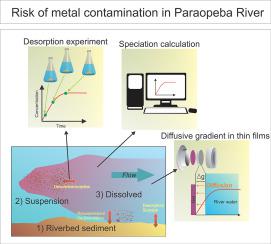Science of the Total Environment ( IF 8.2 ) Pub Date : 2020-12-03 , DOI: 10.1016/j.scitotenv.2020.143917 Elias H. Teramoto , Hendryk Gemeiner , Melina B.T. Zanatta , Amauri A. Menegário , Hung K. Chang

|
On January 25, 2019, a tailings dam at the Córrego do Feijão iron ore mine (Brumadinho, Minas Gerais, southern Brazil) ruptured and released ~12 million m3 of mine tailings into the Paraopeba River, which is an important source of drinking water to a populous region. While water potability due to a strong increase in turbidity has been well documented, possible effects of metal contamination are yet to be addressed. We investigated the speciation of metals in the river water and desorption of metals from sediments as a means of supporting risk assessment, using the diffusive gradient in thin films (DGT) technique, desorption experiments and chemical speciation calculations. The results of the in-situ DGT monitoring revealed that the labile concentrations of metals were low in relation to the respective total and dissolved concentrations. Chemical speciation calculations showed that the heavy metals were not stable in the Paraopeba River. The desorption experiments suggested that sediments may release a limited amount of As and Cu, but large amounts of Mn into the river water. Higher concentrations of Fe and Mn indicated a possible association with the impact of mine tailings. In general, the total metal concentrations during the rainy season were higher than those during the dry season, whereas the reverse was generally the case for labile forms. This pattern reveals that metal speciation is intrinsically dependent on the seasonal variation of the hydrological conditions.
中文翻译:

布鲁玛迪尼奥(BRUMADINHO)大坝破坏后的帕拉欧巴河的金属形态
2019年1月25日,CórregodoFeijão铁矿石矿(巴西南部米纳斯吉拉斯州布鲁马迪尼奥)的尾矿坝破裂并释放约1200万立方米3矿山尾矿排入Paraopeba河,这是人口稠密地区重要的饮用水来源。尽管已经很好地证明了由于浊度的强烈增加而引起的水的可饮用性,但金属污染的可能影响尚待解决。我们使用薄膜中的扩散梯度(DGT)技术,解吸实验和化学形态计算,调查了河水中金属的形态和沉积物中金属的解吸,以作为支持风险评估的一种手段。DGT原位监测的结果表明,相对于各自的总浓度和溶解浓度,金属的不稳定浓度较低。化学形态计算表明,帕拉奥佩巴河中的重金属不稳定。解吸实验表明,沉积物可能会释放出有限量的As和Cu,但会向河水中释放大量Mn。高浓度的铁和锰表明可能与矿山尾矿的影响有关。通常,雨季的总金属浓度高于旱季的总金属浓度,而不稳定形式的情况通常相反。这种模式表明,金属形态本质上取决于水文条件的季节性变化。相反,不稳定形式通常是相反的情况。这种模式表明,金属形态本质上取决于水文条件的季节性变化。相反,不稳定形式通常是相反的情况。这种模式表明,金属形态本质上取决于水文条件的季节性变化。











































 京公网安备 11010802027423号
京公网安备 11010802027423号